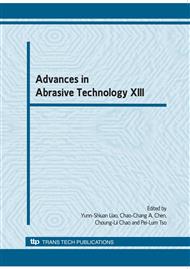p.829
p.835
p.843
p.849
p.855
p.861
p.867
p.873
p.879
Grindability of Micro Pyramid-Structured Surface for Various Hard and Brittle Materials
Abstract:
A novel grinding approach of micro pyramid-structured surface is proposed by using a 60º V-tip of #600 diamond grinding wheel in CNC system. The research objective is to understand the micro grindability of various hard and brittle materials including quartz glass, silicon, SiC ceramics and WC alloy. First, a CNC mutual-wear truing approach was developed to sharpen the wheel V-tip; then, the wheel V-tip was employed to pattern the micro pyramidal array on workpiece surface along CNC tool paths; finally, the machined micro-structured surface and its form accuracy and aspect ratio were investigated. It is shown that this CNC mutual-wear truing approach can not only produce a V-shaped diamond grinding wheel, but also sharpen the diamond grain edges on the wheel V-tip. This wheel V-tip may be used to machine the micron-scale pyramid arrays on silicon, SiC ceramics and WC alloy surfaces with CNC level reticulated cross tool paths, the depth of cut of 1 m and on-machine V-tip form-truing process. Although the average form error of machined micro-structured surface is very small, its pyramidal tops and groove bottoms appear very large form errors, which are dominated by the wheel V-tip sharpness and the grinding conditions, respectively. This leads to a decrease in the aspect ratio by about 38%, 30% and 14% in contrast to the ideal one of 0.87 for silicon, SiC ceramics and WC alloy, respectively.
Info:
Periodical:
Pages:
855-860
Citation:
Online since:
August 2010
Price:
Сopyright:
© 2010 Trans Tech Publications Ltd. All Rights Reserved
Share:
Citation:


